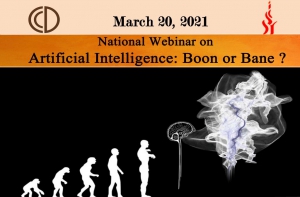
Concept Note
Artificial intelligence (AI), the ability of a digital computer or computer-controlled robot to perform tasks commonly associated with intelligent beings[i]. It was all started in 1950s when a mathematician and computer scientist Alan Turing[ii] designed a test, originally called the ‘imitation game[iii]’, to examine the machine’s ability to be ‘intelligent’ if a human interacting with it could not tell whether it was a person or a machine. It was the first step in the development of what would become the field of Artificial Intelligence (AI), a term first coined by John McCarthy in 1956.
Despite the fact that we are counting on AI as the next tool to revolutionize the way we live, work and interact with each other, it remains unclear as to how these intelligent agents will help to solve more complex problems than the ones existing today e.g. poverty, pandemic, climate changes. So, it become pertinent at current times that we see through social sciences perspective on AI to unpack the rich complexities of sociotechnical settings[iv]. Social sciences with many sub branches[v], devoted to explain what AI means to be human, can provide some interesting insights into how to cope and tackle these changes in our society. . The webinar intends to focus on the following broad themes:
Concerns about AI, Human-being and Society
In the near future, intelligent machines will replace or enhance human capabilities in many areas previously considered strictly within the human domain. Such machines will affect the everyday lives of people in the history of mankind. Although many philosophers, science fiction writers, and others have conjectured about robots and other products related to AI, as far as we know there has been little effort to examine the AI field as a whole in its relation to society in an organized manner. Will machines become super-intelligent and will humans eventually lose control? While there is debate around how likely this scenario will be, we do know that there are always unforeseen consequences when new technology is introduced. Those unintended outcomes of AI will likely challenge us all. The AI algorithms must be built to align with the overarching goals of humans.
AI and Public Policy Initiatives
AI policies and initiatives are gaining momentum in governments, companies, emerging start-ups, technical organizations, civil society and trade unions. With this, national policies are needed to promote trustworthy AI systems. Such policies can spur beneficial and fair outcomes for people and for the planet, especially in promising areas underserved by market-driven investments. The creation of an enabling policy environment for trustworthy AI includes, among other things, facilitating public and private investment in AI research and developing and equipping people with the skills necessary to succeed as jobs evolve.
AI, Legal and Human Rights
Within 21st century’s ‘man meets machine’ reality unfolding, several social and juristic challenges emerge for which we are poorly prepared. Given the potential breadth of its application and use, AI promises to advance the protection and fulfilment of human rights. Examples include, using AI in the analysis of patterns in food scarcity to combat hunger, improving medical diagnosis and treatment or making health services more widely available and accessible, and shedding light on discrimination. In considering the economic, social, ethical, policy and legal implications of AI advances, the national initiatives reflect differences in national cultures, legal systems, country size and level of AI adoption, although policy implementation is at an early stage but it should combine with legal and human right dimensions.
Notes:
[i] Copeland, B.J. "Artificial intelligence". Encyclopedia Britannica, 11 Aug. 2020, https://www.britannica.com/technology/artificial-intelligence. Accessed 13 February 2021.
[ii] Turing, Alan (October 1950), "Computing Machinery and Intelligence", Mind, LIX (236): 433–460, doi:10.1093/mind/LIX.236.433, ISSN 0026-4423
[iii] The test later on famously known by the scientist name as ‘Turing test’. Turing did not call this experiment as "Turing test", but rather the "imitation game"; however, later literature has reserved the term "imitation game" to describe a particular version of the test. Turing gives a more precise version of the question later in the paper: "[T]hese questions [are] equivalent to this, 'Let us fix our attention on one particular digital computer C. Is it true that by modifying this computer to have an adequate storage, suitably increasing its speed of action, and providing it with an appropriate programme, C can be made to play satisfactorily the part of A in the imitation game, the part of B being taken by a man?'" (Turing 1950, p. 442)
[iv] Lindgren, Simon and Holmstrom, Jonny. 2020. Artificial Intelligence: Building Blocks for a Research Agenda, Journal of Digital Social Research, Vol. 2, No. 3, pp 1–15, https://doi.org/10.33621/jdsr.v2i3.65.
[v] Miller, Tim. 2019. Explanation in artificial intelligence: Insights from the social sciences, Artificial Intelligence, Volume 267, Pages 1-38,https://doi.org/10.1016/j.artint.2018.07.007.


Add Comment